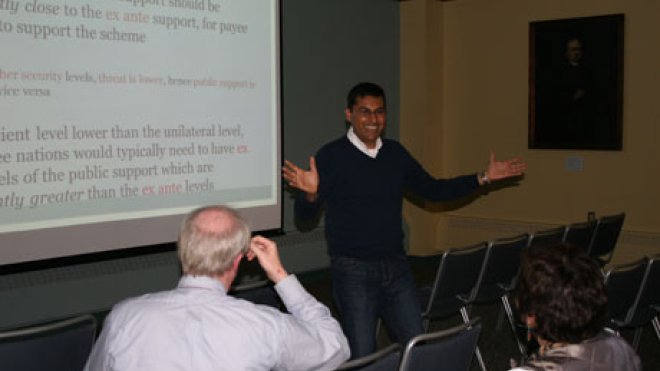Diverse Research Presented at Fall Faculty Showcase

From the man who built the Mount Hope Bridge to understanding how the United Nations handles global threats, Roger Williams University faculty members shared their latest research projects at last Thursday’s Fall Faculty Showcase.
The event was designed to foster collegiality among faculty members and offer a venue to share their latest research projects, pedagogy and creative works, according to Margaret Case, one of the organizers of the inaugural faculty showcase. Presenters included Associate Professor of Architecture Gary Graham, Associate Professor of Architecture Robert Dermody and Assistant Professor of Economics Rupayan Gupta.
Here are highlights from their presentations:
Gary Graham: "Can We Teach Lean Construction Methods in Schools of Architecture?"
• The primary concept that needs to be addressed is collaboration between the owner (or, the client), designer and constructor. The teamwork and cooperation essential for these new collaborative project delivery methods are only beginning to be realized by the design and building professions.
• Universities must expose students to the process of collaboration without diminishing the design aspect, because the designer is still crucial to the effectiveness of the project.
• Three important terms: Lean – based on the post-World War II Japanese design concept of change and continuous improvement; Building Information Modeling (BIM) – smart virtual models that contain all elements of a construction project, from cost to design to the timeline; and Integrated Project Delivery (IPD) – having the key design and construction professionals involved in a project work together with the owner to produce the project in a spirit of cooperation, collaboration and trust.
• The building owners – who have been frustrated by the lack of productivity in the design and building industry are demanding efficiency and predictability – have driven this new collaborative approach.
• RWU has begun teaching this new collaborative method since 2010. Architecture and construction management students worked together on designing and planning a new Community Center for the Town of Barrington; planning this project is now underway by a volunteer community task force. This semester, students will collaborate on a Warren Animal Shelter.
Robert Dermody: "David Steinman: American Bridge Builder"
• David Steinman (1886-1960) designed more than 400 bridges during his more than 40-year career as a structural engineer – that’s one bridge a month. The Mount Hope Bridge is one of his early suspension bridges.
• The Mount Hope Bridge opened on October 24, 1929. Five days later, the stock market crashed and set off the Great Depression.
• Steinman grew up within miles of the Brooklyn Bridge, and he was involved in the bridge renovation project in the 1950s – “a coup for him,” according to Dermody.
• But the big commission for designing a major metropolitan bridge like the one from his childhood always eluded Steinman throughout his career.
• Steinman believed that bridges should be beautiful as well as efficient. He was one of the first designers to have his bridges painted an appropriate color and to have his bridges illuminated with decorative (as well as functional) lights.
• While most of his contemporaries were immigrants from Europe, Steinman was born, educated and trained in the U.S.
• Add researcher, scholar and prolific writer to Steinman’s résumé. He published several hundred research articles and many books.
• He rode a horse around the campus of the University of Idaho, where he held his first teaching position in the 1920s.
• Steinman dedicated 17 years of his career to researching how wind affects bridges and devising solutions to the problems.
Rupayan Gupta: "Designing International Institutions for Global Security"
• Countries support having international institutions such as NATO and the United Nations, but sometimes do not have a clear idea of how these organizations should collectively approach issues of global security.
• Gupta strives through his research to design objectives to address the issues of international institutions using “Bargaining Theory” and “Mechanism Design.” Bargaining Theory has members of the organization bargain over the level of effort to be made until the parties are satisfied. Mechanism Design is a way to “fix the rules of the game in a certain way so that the game leads to the outcome of your choice.”
• Take, for example, what effort allied countries must engage in to achieve global security. Gupta applies John Nash’s “Game Theory” to how U.N. member nations of a supranational institution should proceed when determining what to do about a global threat. He says nations must ally together against the threat and come up with a game plan to act together.
• Under certain circumstances, one country might want a higher level of effort than others. Countries must weigh and balance the level of effort – some will increase their contributions towards the security effort, and the country with the highest proclivity for security will decrease its effort. This actually helps the coalition transition from a “unilateral” effort level that is undesirable in a collective sense, to a collectively desirable “efficient” level.
• It seems likely that the level of engagement offered by a member will determine how much of a say it will have in the ultimate level of security effort provisioned by the coalition. Gupta shows that the level of public support for such an effort within a country will crucially determine that country’s level of engagement in global security actions.
The RWU Faculty Association sponsored the Fall Faculty Showcase. RWUFA public relations committee members James Beitler, Mary Wu, Barbara Kenney, Autumn Quezada-Grant and Margaret Case organized the fall showcase and are planning a spring event, with the format and date to be determined.